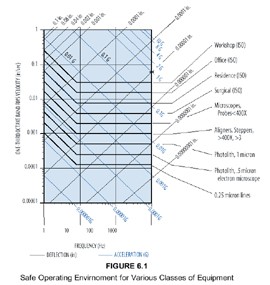When Is Vibration Control Necessary
When Is Vibration Control Necessary
When is it needed?
When Is Vibration Control Necessary?
- In new buildings or facilities, KSI recommends, and can provide, onsite vibration surveys to define the environment. Results that indicate vibration amplitudes at frequencies exceeding the applicable equipment specification criteria require isolation.
- If new equipment is being installed in an existing facility where other equipment is performing successfully with vibration isolation, then isolation should be continued and applied for the new equipment. It is substantially more cost- and time-effective to continue a successful practice rather than experiment with a new, unknown situation.
- If new equipment is being installed in an existing facility where no other equipment is isolated, you may continue the practice of no isolation. However, new equipment designs generally embody more precision and are therefore more sensitive than the older equipment. We recommend isolation in this situation as a fail-safe solution, especially if time is a critical factor for going online.
How Much is Enough?
How Much Vibration is Acceptable?
Look at the Application.
Due to the large variety of instrument components and designs, equipment sensitivity to vibration is a subject of continuing research. So the question of “How much vibration is acceptable” is not precisely known. Equipment manufacturers typically strive to achieve specified performance tolerances in a benign or noncritical development laboratory environment. It is the end user’s responsibility to provide a “safe operating vibration environment”at the point of installation. There are limited available data on the ability of various classes of equipment to withstand vibration. These data have been compiled from various surveys and are presented in Figure 6.1 to represent proposed safe operational vibration levels for a variety of sensitive instruments. Each equipment line represents an acceptable envelope of rms vibration amplitude vs frequency which is not to be exceeded. The “allowable” vibration envelopes in Figure 6.1 have been proposed by various engineering committees for standardization by the International Standards Organizations (ISO) to supplement their existing standards.
Kinetic Systems Takes the Guesswork Out of Vibration Control
Kinetic Systems, Inc. is a world leader in the development and application of advanced low frequency vibration control systems that provide vibration-free work environments for sensitive equipment. An overview of our experience and successful vibration control methods are presented to assist you with the selection of proper cost-effective vibration isolation for your particular application.
Vibration Control At “Point of Installation”

For end user applications, KSI manufactures complete lines of active-air and passive-air
mounts, platforms and tables, with load capacities from 200 lbs to 20,000 lbs per unit isolator. Standard or custom design table and platform configurations can be provided for research applications involving special assemblies of elements which are inherently vibration sensitive, such as probers, mask aligners, microscopes and the like.
Vibration Control At “Point of Design”

For OEM applications, KSI manufactures unit active-air vibration isolators which are readily integrated into equipment to protect platforms and trays holding vibration sensitive elements. This is a cost-effective and space saving approach to achieve vibration control by process equipment manufacturers. When an equipment design is fixed and an integrated internal isolation system is not feasible, KSI can furnish a custom designed external isolation table or platform to provide the desired vibration environment protection.
We have performed all the necessary calculations, and relying on over thirty years of applied vibration control experience, offer the end-user point of installation pre-engineered, all-purpose, low frequency, vibration-free tables and platforms for tabletop and floor mounted equipment. For the OEM, KSI offers unit active air mounts in capacities and dimensions suitable for custom integration with internal system components and structures.
Most importantly, unless your work environment is unusually prone to dramatic vibration fluctuations, KSI Vibration Isolation Systems and Optical Tables will perform flawlessly for you.
So feel free to browse the technical section of this website. However if your need is for high performance vibration isolation equipment or optical tables and you don’t want to bother with all the technical jargon, go directly to the product section, select a workstation or table that looks right for you, and contact us. We will ask you a few very simple questions and very quickly get you to a solution that will work for you. No Hassles.
All Buildings Vibrate
All buildings vibrate… activities of people, machinery, heating and ventilation systems, and nearby truck or rail traffic cause all sorts of vibrations. These vibrations, although acceptable to occupants, cannot be tolerated by equipment used in research, precision manufacturing, inspection, and quality control.

Ambient vibration levels in buildings, laboratories, and cleanrooms vary widely. Figure 5.1 shows a typical time sample of a severe building vibration environment. The vibration is a random amplitude and random frequency disturbance. In this environment, sensitive electromechanical equipment will experience a variety of problems such as structural damage and excessive signal noise. Optical equipment will experience low frequency jitter and high frequency image blur and line thickening. The short term effects are inconsistent and unreliable performance. The long term effects are excessive wear, maintenance and fatigue failures.
In order to protect sensitive instruments and equipment from faulty operation or failure this vibration must be significantly reduced. This can be efficiently accomplished by using a KSI VIBRAPLANE ISOLATION system either by the end user at the point of installation; or integral to the equipment by OEM designers at a point where the vibration sensitive components are installed.

A four-coordinate vibration nomograph has been superimposed in Figure 6.1. The inclined coordinates of the nomograph conveniently allow direct reading of rms vibration amplitude as a function of frequency in units deflection, in., velocity, in./sec, or acceleration, G in multiples of gravity, g.
The data are very conservative and represent subjective opinions as to the onset of operational problems such as signal noise or optical blurring. They don’t represent structural damage or failure. Further, the data are rms 1/3 octave band width (23%) filter analyses. Adjustment is necessary if comparing to data with different measurement bandwidths.
NOTE: For “Point of Design” vibration control, equipment designers should include attention to mass, stiffness and damping. For best results, KSI recommends that moving parts be lightweight, rigid and damped. Stationary parts should be heavy, rigid and damped. Sensitive elements are best placed together on a rigid platform inside the equipment console for grouped isolation. Whatever your design entails, KSI can help by providing custom fit vibration protection for all the sensitive components.
Article Source : https://www.kineticsystems.com/about-vibration-control/